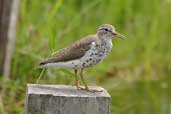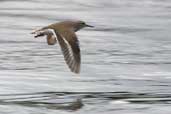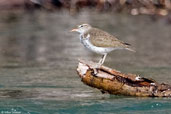(aka Actitis macularia) Brazilian name: Maçarico-pintado

Just as it's good to see a Solitary
Sandpiper on its own, its good to see a Spotted Sandpiper with
spots. This is not always the case in South America since the
spots are part of its breeding plumage and it is normally seen
without spots during the northern winter.
However, the bird in photos 1 and 2 is on its migration back
north and is well on its way to full breeding plumage. The spots
on the underparts will become even more widespread, the bill will
become orange to pink with a black tip and the legs may become
pinker. Photo 3 was taken in the Yukon, Canada in
June.

Out of breeding plumage, when the spots are not visible, the bird is constantly bobbing or "teetering" the rear part of its body as can be seen in the attached video from the Internet Bird Collection . The white peak between the breast patches and the wing are also diagnostic as is the stiff-winged style of flight and the white wing-bar as seen in the second photo.

There are recordings on xeno-canto, a distribution map from NatureServe and additional information available via Avibase. There is a page in Portuguese on Wikiaves.
| Previous Page | Back to Index | Next Page |